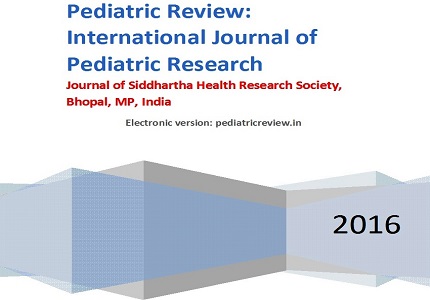Neonatal ECMO
Abstract
ECMO is a technique of providing cardiac & respiratory support to sustain life. Nowadays it is being increasingly used in newborns. Respiratory ECMO is used for severe respiratory distress syndrome, pneumonia & meconium aspiration syndrome. Cardiac ECMO is used after open heart surgery, myocarditis or myopathy. There are two types of ECMO, Veno-Venous (V-V) bypass & Arterio-Venous (A-V) bypass. ECMOcan be used to bridge patients with heart failure as they await heart transplantation & as an adjunct to cardiopulmonary resuscitation. ECMO should be used in reversible diseases only after analysing various factors. Qualifying criteria for ECMO are applied only when the infant has reached maximal ventilatory support. Only babies with gestational Age > 34 weeks, Birth Weight > 2,000 grams, without major coagulopathy, with mechanical ventilation < 14 days & reversible lung disease are eligible for ECMO. Absolute contraindications include Grade 3 or 4 IVH, irreversible brain injury, lethal malformations, non-treatable congenital heart disease & significant coagulopathy. The ECMO circuit consists of a cannula to drain deoxygenated blood from the patient, a pump, an artificial lung to provide oxygenation & ventilation, heat exchanger, a second cannula to return oxygenated blood back to the patient Management during ECMO includes Oxygenation, Inotropic support, Rest Ventilation & Sedation. Complications include Bleeding, Infection, myocardial stun, neurodevelopmental problems, Pneumothorax, pulmonary haemorrhage, bronchial asthma, Sensorineural disabilities,acute tubular necrosis, Feeding difficulty, metabolic derangements, Psychosocial morbidity & Neuromotor deficits .Early initiation of ECMO, monitoring & prompt management of expected complications will improve survivalwithout severe disability.
Downloads
References
2. Field DJ, Firmin R, Azzopardi DV, Cowan F, Juszczak E, Brocklehurst P; NEST Study Group. Neonatal ECMO Study of Temperature (NEST)--a randomised controlled trial. BMC Pediatr. 2010 Apr 19;10:24. doi: 10.1186/1471-2431-10-24. [PubMed]
3. Bartlett RH, Andrews AF, Toomasian JM, Haiduc NJ, Gazzaniga AB. Extracorporeal membrane oxygenation for newborn respiratory failure: forty-five cases. Surgery. 1982 Aug;92(2):425-33. [PubMed]
4. O'Rourke PP, Crone RK, Vacanti JP, Ware JH, Lillehei CW, Parad RB, Epstein MF. Extracorporeal membrane oxygenation and conventional medical therapy in neonates with persistent pulmonary hypertension of the newborn: a prospective randomized study. Pediatrics. 1989 Dec;84(6):957-63. [PubMed]
5. Heather Carriedo, Douglas Deming. Therapeutic Techniques: Neonatal ECMO. NeoReviews; August 2003, Volume 4 / Issue 8.
6. Barrett CS, Bratton SL, Salvin JW, Laussen PC, Rycus PT, Thiagarajan RR. Neurological injury after extracorporeal membrane oxygenation use to aid pediatric cardiopulmonary resuscitation. PediatrCrit Care Med. 2009 Jul;10(4):445-51. doi: 10.1097/PCC.0b013e318198bd85.
7. Schumacher RE, Roloff DW, Chapman R, Snedecor S, Bartlett RH. Extracorporeal membrane oxygenation in term newborns. A prospective cost-benefit analysis. ASAIO J. 1993 Oct-Dec;39(4):873-9. [PubMed]
8. Mugford M, Elbourne D, Field D. Extracorporeal membrane oxygenation for severe respiratory failure in newborn infants. Cochrane Database Syst Rev. 2008 Jul 16;(3):CD001340. doi: 10.1002/14651858.CD001340.pub2. [PubMed]
9. Brogan TV, Thiagarajan RR, Rycus PT, et al. Extracorporeal membrane oxygenation in adults with severe respiratory failure: a multi-center database. Intensive Care Med. 2009 Dec;35(12):2105-14. doi: 10.1007/s00134-009-1661-7. Epub 2009 Sep 22.
10. Peter Betit , Nancy Craig . Extracorporeal Membrane Oxygenation for Neonatal Respiratory Failure.Respiratory care.Sep 2009, vol 54(9).
11. Thiagarajan RR, Laussen PC, Rycus PT, Bartlett RH, Bratton SL. Extracorporeal membrane oxygenation to aid cardiopulmonary resuscitation in infants and children. Circulation. 2007 Oct 9;116(15):1693-700. Epub 2007 Sep 24. [PubMed]
12. Thiagarajan RR, Brogan TV, Scheurer MA, Laussen PC, Rycus PT, Bratton SL. Extracorporeal membrane oxygenation to support cardiopulmonary resuscitation in adults. Ann Thorac Surg. 2009 Mar;87(3):778-85. doi: 10.1016/j.athoracsur.2008.12.079.
13. Concepts of Neonatal ECMO.The Internet Journal of Perfusionists 1 (2). 2001.doi:10.5580/d9.
14. Jobe, Alan H. Post-conceptional age and IVH in ECMO patients. The Journal of Pediatrics 145 (2): A2. doi:10.1016/j.jpeds.2004.07.010.
15. Bui KC, LaClair P, Vanderkerhove J, Bartlett RH. ECMO in premature infants. Review of factors associated with mortality. ASAIO Trans. 1991 Apr-Jun;37(2):54-9. [PubMed]
16. Gaffney AM, Wildhirt SM, Griffin MJ, Annich GM, Radomski MW. Extracorporeal life support. BMJ. 2010 Nov 2;341:c5317. doi: 10.1136/bmj.c5317. [PubMed]
17. Sell LL, Cullen ML, Whittlesey GC, Yedlin ST, Philippart AI, Bedard MP, Klein MD. Hemorrhagic complications during extracorporeal membrane oxygenation: Prevention and treatment. J Pediatr Surg. 1986 Dec;21(12):1087-91.
18. Cilley RE, Zwischenberger JB, Andrews AF, Bowerman RA, Roloff DW, Bartlett RH. Intracranial hemorrhage during extracorporeal membrane oxygenation in neonates. Pediatrics. 1986 Oct;78(4):699-704. [PubMed]
19. von Allmen D, Babcock D, Matsumoto J, Flake A, Warner BW, Stevenson RJ, Ryckman FC. The predictive value of head ultrasound in the ECMO candidate. J Pediatr Surg. 1992 Jan;27(1):36-9. [PubMed]
20, Northway WH Jr, Rosan RC, Porter DY. Pulmonary disease following respirator therapy of hyaline-membrane disease. Bronchopulmonary dysplasia. N Engl J Med. 1967 Feb 16;276(7):357-68. [PubMed]
21. Kornhauser MS, Cullen JA, Baumgart S, McKee LJ, Gross GW, Spitzer AR. Risk factors for bronchopulmonary dysplasia after extracorporeal membrane oxygenation. Arch Pediatr Adolesc Med. 1994 Aug;148(8):820-5.
22. Hardart GE, Hardart MK, Arnold JH. Intracranial hemorrhage in premature neonates treated with extracorporeal membrane oxygenation correlates with conceptional age. J Pediatr. 2004 Aug;145(2):184-9.
23.Larsson M, Rayzman V, Nolte MW, et al. A Factor XIIa Inhibitory Antibody Provides Thromboprotection in Extracorporeal Circulation Without Increasing Bleeding Risk. SciTransl Med 2014;6 (222): 222. doi:10.1126/scitranslmed.3006804.
24. MohanKumar K. Intestinal epithelial apoptosis initiates gut mucosal injury during extracorporeal membrane oxygenation in the newborn piglet. Lab Invest. 2014;94 (2): 150–160. doi:10.1038/labinvest.2013.149.

Copyright (c) 2016 Author (s). Published by Siddharth Health Research and Social Welfare Society

This work is licensed under a Creative Commons Attribution 4.0 International License.


 OAI - Open Archives Initiative
OAI - Open Archives Initiative


